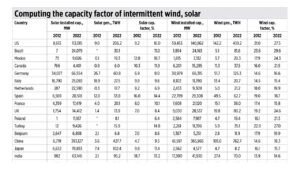Energizing growth via less intermittent wind, solar

(Part 4 of a series)
As usual, we go straight to the numbers to quickly show the data behind this column’s argument. We computed the capacity factor, the ratio or percent of actual electricity generated by a given installed capacity in a given year. It is measured as total electricity produced in terawatt-hours (TWH) divided by the amount of energy produced if the plant was running at full capacity.
In mathematical form: Capacity factor (in %) = Generation in TWH / {installed capacity in megawatt (MW) x 24 hours/day x 365 days/year}.
The higher the capacity factor, say above 60%, the more reliable and stable the energy source is, the less land or water surface will be needed to generate a TWH or 1 million megawatt-hours (MWH) of electricity.
The computed average capacity factor for solar in the world was only 8.5% in 2012, and 11% in 2022. Even industrial Germany and Netherlands had a low solar capacity factor of only 7-9% in 2022. The Philippines has 10%.
For wind, the computed average capacity factor in the world was 14.6% in 2012 and 18.3% in 2022. Industrial Germany, Italy, and France have a wind capacity factor of only 15-17% in 2022. The Philippines has 22% (see the Table).
There could be nuances in the numbers like some big solar and wind projects were commissioned only in the 4th quarter of the year and hence their TWH generation for the year is low. But since these are cumulative figures, such nuances should be small compared to the accumulated total installed capacity and overall power generation.
A low capacity factor of only 11-18% for solar and wind (versus 80% and above for coal and gas, 90-100% for nuclear) means more land or water surface (lake or sea) will be needed to generate one TWH of electricity. To expand land use in order to expand power generation from intermittent wind and solar means less land will be available for food production, housing, industry and roads, or less forest land for environmental protection.
Floating solar panels on lakes and dams will help solve the problem of land competition but this will reduce the amount of sunlight able to reach the lakebed and might adversely affect phytoplankton and the marine food chain. Offshore wind will also help solve the problem of land competition, but this will lead to less leeway for commercial fishing.
All these onshore or offshore projects will have adverse impacts on the production of food, consumer, and capital goods. Which will have an inflationary impact on their prices. It is not good if we aspire for faster and sustained growth, more job creation, and poverty reduction in the country and the world.
Meanwhile, here are some interesting articles that I read recently: “California is curtailing more solar power than ever before” (Curtailment, or deliberately reducing output, rises as solar generation exceeds available transmission capacity) by Ryan Kennedy, PV-Magazine USA, Oct. 31; and “A Solar Expert Shares Her Opinions, and Isn’t Afraid to Change Them” by Nathaniel Bullard, Bloomberg, Nov. 2.
And here are some recent reports in BusinessWorld: “RE share should be 80% if PHL serious about meeting Paris promises — think tank” (Oct. 30), “BoI endorses wind power project for ‘green lane’” (Nov. 5), “RE transition to require power grids to make major adjustments — report” (Nov. 5), “Wind, solar, gas dominate DoE lineup of prospective projects” (Nov. 5).
To briefly conclude, here are five points to consider.
1. We should focus on fast, sustained growth that will require a big supply of stable, reliable, dispatchable-on-demand electricity at competitive, non-subsidized prices. We are still a developing country with low power generation capacity and hence, there are occasional blackouts any day in any month.
2. The persistent strong push to have more intermittent wind-solar in the country will be good for the renewable energy (RE) companies and other lobby groups but can be contradictory to our overall goal of faster and sustained growth and job creation.
3. Food production should prevail over intermittent power generation. The conversion of agricultural land — rice, corn, sugar and other crops — into solar farms should be minimized or controlled.
4. The disposal of millions of tons of old decommissioned solar panels, wind turbines, and huge towers in the long term should be considered in the planning of expanding intermittent energy. They have to consider where to dump these.
5. Fossil fuels, especially coal, plus nuclear power are more conducive to faster economic growth than intermittent sources of energy. This column’s “Energizing growth” series have shown the numbers. See Part 3, “Coal and nuclear power as growth drivers” (Oct. 26), Part 2, “Energizing growth: Lessons from UAE, France, and other countries” (Oct. 17), and Part 1, “Energizing growth: The role of fossil fuels in economic development” (Oct. 3).
Meanwhile, the BusinessWorld Economic Forum 2023 with the theme “Forecast 2024” will be held on Nov. 22 at the Grand Hyatt Manila in BGC, Taguig City. As energy outlook is also economic outlook, energy forecasting should be one of the topics discussed there.
Bienvenido S. Oplas, Jr. is the president of Bienvenido S. Oplas, Jr. Research Consultancy Services, and Minimal Government Thinkers.




